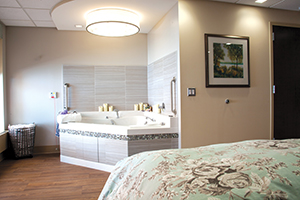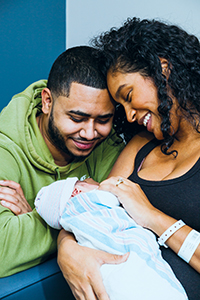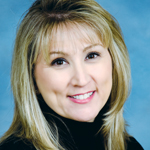Birth centers are increasingly popular, according to accrediting agency
By JULIE MINDA
Saint Peter's University Hospital in New Brunswick, New Jersey, has opened a birth center that is in the same hospital building as its labor and delivery unit, but operates independently.
According to the new center's leadership, having the birth center in the hospital provides an alternative for women who want low-intervention births in a nonmedicalized and homelike setting while also having the safety net of a high-tech labor and delivery unit nearby, in case complications arise during delivery.

Each of the two birthing suites at the birth center has a queen-sized bed, spa tub and shower. The décor is homelike and no medical equipment is visible.
"It is truly the best of both worlds — a stunningly beautiful, quiet and comfortable space to bring a new life into the world, but with all the resources of the hospital, just a few floors away," Joanne Cunha said in a press release issued following the center's opening in November. Cunha is a certified nurse midwife and clinical director of Saint Peter's midwifery services.
Saint Peter's facility has been accredited by the American Association of Birth Centers. According to that agency, accreditation involves verifying that a birth center has met a high standard of evidence-based benchmarks for maternity care, neonatal care, business operations and safety. The agency says it has a quality improvement program, that, in conjunction with the accreditation standards, confirms the delivery of quality care through the use of external quality measures.

Emely Madera and Hassan Hazim admire their newborn son, Zane. Born on Nov. 17, he is the first baby delivered at Saint Peter’s University Hospital’s Mary V. O’Shea Birth Center.
The accrediting association says birth centers should provide "a home-like setting where care providers, usually midwives, provide family-centered care to healthy pregnant women." Currently there are 399 association certified birth centers in 39 states and the District of Columbia. Fifteen of those centers are inside a hospital. The agency notes that "birth centers have consistently displayed charges for care for normal birth that average up to 50% less than charges for an uncomplicated birth in the hospital."

Harmon
Like home
The Saint Peter's facility's two birthing suites look like bedrooms. All the décor is soothing — there are paintings of nature scenes on the walls, and the rooms' color scheme is in soft hues. And there is no visible medical equipment, said Pam Harmon, director of women and children's services at Saint Peter's and administrative director of Saint Peter's new facility, which is called the Mary V. O'Shea Birth Center. It is named in memory of a longtime New Brunswick resident who bequeathed a portion of the funds for the $2.1 million center; Saint Peter's provided the remainder.
Each birthing suite has a standard queen-sized bed, spa-sized tub and shower as well as space and furniture to accommodate the family members attending the birth. Patients and their families have access to a communal lounge area, dining room and kitchen.
Natural process
The birth center's approach is rooted in the philosophy that birth is a natural process and that medical intervention should only be used when necessary. The birth center follows the midwifery model of care. Midwifery is childbirth assistance by a trained professional.
The New Brunswick birth center staff of about a dozen includes three certified nurse midwives — with more to be hired in the near term — as well as patient care technicians who are trained as doulas to provide physical and emotional support, plus nurses and office administrative staff.
Patients sign on with the center early in their pregnancy and then attend classes there in the ensuing months to get to know the center's staff and to learn about the center's midwifery model of care and natural approach to labor and pain control. The expectant moms work with the clinical staff to develop a birth plan. Cunha said the center's approach is holistic. "We spend time. We educate. It's an inclusive, personalized, one-on-one approach."
Patients receive regular prenatal exams from the midwives at the center, including to verify their pregnancy continues to be low-risk. An abnormal blood pressure or blood sugar level, for instance, could make a woman ineligible to give birth at the center.
Go time
A midwife, a registered nurse and a doula assist in each delivery.
Unlike in the labor and delivery unit, women laboring in the birth center cannot opt to have an epidural or other pain medication. Center clinicians offer hydrotherapy, aromatherapy, nerve stimulation and massage. Patients are not tethered to their bed by fetal monitoring equipment, so they can walk around as they wish. Clinicians use handheld instruments to periodically monitor babies' heartbeats.
If a delivery at the center becomes complicated, say a mother requires an emergency cesarean section, clinicians can immediately transport the patient to Saint Peter's labor and delivery unit where an on-call physician will take over care. Harmon said that freestanding birth centers must transport patients by ambulance in the event of a serious complication.
Courting the community
Saint Peter's has well-established labor and delivery services. With about 5,200 births last year, the hospital logs the most births in the region.
Harmon credits Dr. Elizabeth Cherot, an obstetrician, for suggesting that the hospital open an in-house birth center.
Cherot noted a growing interest in low-intervention births and a lack of options locally for women who preferred a less technical approach to birthing, but didn't want to deliver at home. Saint Peter's assembled a committee to study the local market, and it confirmed Cherot's thesis that many women wanted to have the control that home delivery affords, but they feared the potential risk that comes with a home birth, should complications arise.
The American Association of Birth Centers said the number of birth centers has increased 82 percent since 2010, and the industry is continuing to grow.
Harmon said the committee found that women contemplating home births or natural births could be a new market for the hospital.
The center had delivered 10 babies as of early March. Since it is so new, it does not yet have a large patient base. But Harmon said there is much interest and excitement from the community. "We're getting lots of positive attention," she said.